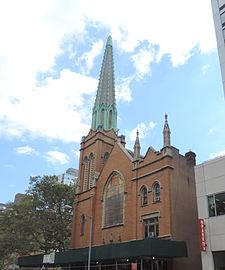
The Church of the Intercession is an Episcopal congregation located at 550 West 155th Street, at Broadway, on the border of the Harlem and Washington Heights neighborhoods of Manhattan, New York City, on the grounds of Trinity Church Cemetery. The congregation was founded in 1846, and the current sanctuary, built in 1912–1915, was designed by Bertram Grosvenor Goodhue in the Gothic Revival style. From 1906–1976, it was a chapel of Trinity Church.

Trinity Evangelical Lutheran Church is a Victorian Gothic-style Lutheran church built in Milwaukee, Wisconsin in 1878 - then claimed to be "the finest church edifice within the Missouri Synod." Today it is listed on the National Register of Historic Places and is a designated State Historic Site. The building was also declared a Milwaukee Landmark in 1967, and today is the oldest church associated with the Lutheran Church–Missouri Synod in the city.

St. Paul's Chapel is a chapel building of Trinity Church, an episcopal parish, located at 209 Broadway, between Fulton Street and Vesey Street, in Lower Manhattan, New York City. Built in 1766, it is the oldest surviving church building in Manhattan, and one of the nation's finest examples of Late Georgian church architecture.

St. Michael's Church is a historic Episcopal church at 225 West 99th Street and Amsterdam Avenue on Manhattan's Upper West Side in New York City. The parish was founded on the present site in January 1807, at that time in the rural Bloomingdale District. The present limestone Romanesque building, the third on the site, was built in 1890–91 to designs by Robert W. Gibson and added to the National Register of Historic Places in 1996.

The Historic Trinity Lutheran Church is a church located in downtown Detroit, Michigan. It occupies the Trinity Evangelical Lutheran Church complex, located at 1345 Gratiot Avenue. It was designated a Michigan State Historic Site in 1981 and listed on the National Register of Historic Places in 1983. Its current pastor is Rev. Darryl L. Andrzejewski.

German Evangelical Lutheran Church of St. Mark is a historic church and synagogue building at 323 East 6th Street between First and Second Avenues in the East Village neighborhood of Manhattan, New York City. The Renaissance Revival style church was built in 1847 by the Evangelical Lutheran Church of St. Matthew which first rented it to St. Mark's and subsequently sold it to them in 1857. By the end of the nineteenth century the congregation was in decline as congregants were moving elsewhere. Much of the church membership was killed in the 1904 General Slocum disaster, most of the victims being women and children, and the congregation never recovered.

Zion-St. Mark's Evangelical Lutheran Church, formerly known as Deutsche Evangelische Kirche von Yorkville and Zion Lutheran Church, is a historic Lutheran church at 339-341 East 84th Street in Yorkville, Manhattan, New York City. The congregation is a member of the Evangelical Lutheran Church in America.

Zion Lutheran Church is a historic Lutheran church located along Prospect Avenue near downtown Cleveland, Ohio, United States. Formed in the 1840s, the congregation built the present building shortly after 1900, along with an adjacent church school. Both buildings have been named historic sites. The school is no longer open.

The Holy Trinity Church, St. Christopher House and Parsonage is a historic Episcopal church located at 312-316 and 332 East 88th Street on the Upper East Side of Manhattan in New York City. The building was built in 1897.

St. Paul Lutheran Church is located in central, Davenport, Iowa, United States. It is affiliated with the Evangelical Lutheran Church in America (ELCA). The church's original property, which subsequently housed other Protestant congregations, was listed on the National Register of Historic Places in 1983, but has since been torn down. The present complex was built in 1952 and contains two buildings that are contributing properties in the Vander Veer Park Historic District. The present church building was completed in 2007.
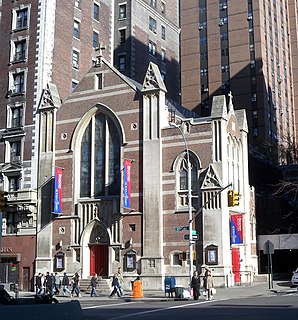
Advent Lutheran Church is a church affiliated with the Evangelical Lutheran Church in America located in the Upper West Side, Manhattan, New York City. The church building was designed by the architectural firm of William Appleton Potter (1842–1909).
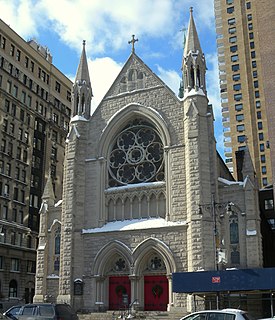
Holy Trinity Lutheran Church is a Lutheran church located at 3 West 65th Street at the corner of Central Park West in the Upper West Side neighborhood of Manhattan, New York City. It is a member of the Evangelical Lutheran Church in America.

The Evangelical Lutheran Church of St. Matthew is the oldest Lutheran congregation in North America. The congregation is a member of the Lutheran Church–Missouri Synod. Since 2006, the congregation has been located at the Cornerstone Center, 178 Bennett Avenue in Manhattan, New York City. The congregation has been known by different names, only acquiring the name St. Matthew in 1822 and using it exclusively since 1838.

Saint Luke's Lutheran Church, also known as The German Evangelical Lutheran Congregation of Saint Luke's and St. Luke's Evangelical Lutheran Church, is a historic Lutheran church located on Restaurant Row at 308 West 46th Street between Eighth and Ninth Avenues in the Theater District of Manhattan, New York City.

George Willard Conable (1866-1933), AIA, was an American architect practicing in New York City in the early to mid 20th century specializing in churches.
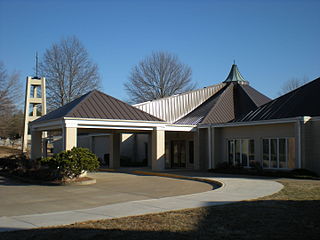
Hanover Lutheran Church is a Lutheran congregation in Cape Girardeau, Missouri, that is a member of the Lutheran Church–Missouri Synod. The congregation's original organization came about in 1846 as a result of the heavy German immigration to Missouri in the 19th century. The church's name, "Hanover", was chosen to reflect the place of origin of the majority of its members, since many of the Germans who had settled northwest of the town of Cape Girardeau had immigrated from Hanover, Germany.
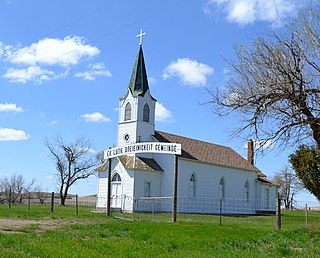
Evangelisch Lutheraner Dreieinigkeit Gemeinde, or Evangelical Lutheran Trinity Church is near New Leipzig, North Dakota. It has also been known as Trinity Heupel Church and as Heupel Church. The church building was listed on the National Register of Historic Places (NRHP) in 2009

Zion Lutheran Church, also known as the Zion Church of the City of Baltimore, is a historic Evangelical Lutheran church located in downtown Baltimore, Maryland, United States, founded 1755.

The Swedish Evangelical Lutheran Church is a historic church building in Millville, Minnesota, United States. It was built in 1874 and used successively by Swedish, Norwegian, and German immigrant congregations. The church and its adjacent cemetery were listed on the National Register of Historic Places in 1989 for having local significance in the theme of European ethnic heritage. It was nominated for being the only intact surviving ethnic church from the peak of European immigration to Wabasha County.
Frederick W. Velguth was an architect in Milwaukee, Wisconsin. Several buildings he designed are listed on the National Register of Historic Places.
